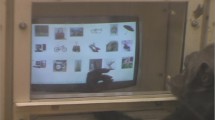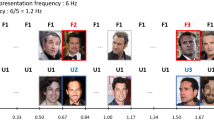Abstract
Prosopagnosic patients may maintain some ability to recognize familiar faces, although they remain unaware of this ability. This phenomenon – called covert face recognition – was investigated in neurologically intact participants, using priming techniques. Participants were quicker to indicate that a target-name was familiar when the preceding prime-face belonged to the same person compared with an unrelated familiar person. This was observed both when prime-faces could be recognized overtly and when they were presented too briefly to be recognized overtly (Exps. 1 and 2). Thus, covert face recognition was observed in neurologically intact participants. In Exp. 3, participants were quicker to recognize a familiar face when that person's face had been seen previously, but only when it had been recognized overtly on the first encounter. These results are interpreted within the framework of an interactive activation model of face recognition.
Similar content being viewed by others
Author information
Authors and Affiliations
Additional information
Received: 21 September 1998 / Accepted: 2 March 1999
Rights and permissions
About this article
Cite this article
Morrison, D., Bruce, V. & Burton, A. Covert face recognition in neurologically intact participants. Psychological Research Psychologische Forschung 63, 83–94 (2000). https://doi.org/10.1007/s004260000037
Issue Date:
DOI: https://doi.org/10.1007/s004260000037




